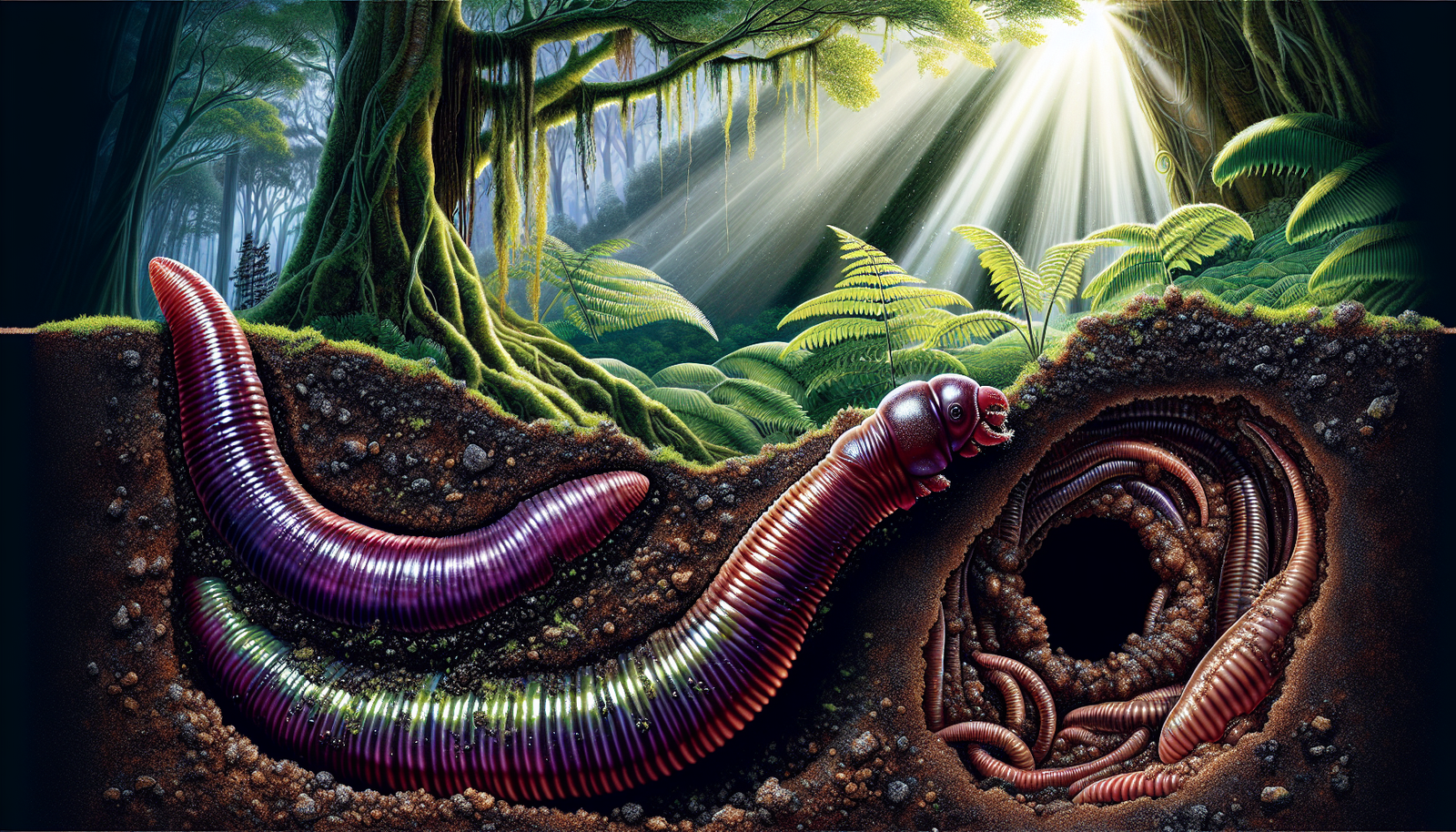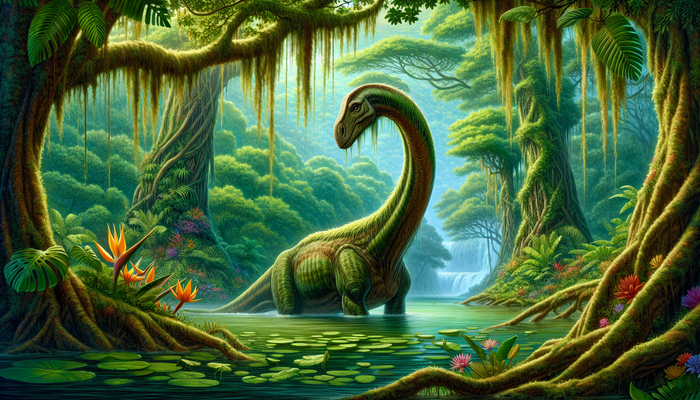Unearthing the World's Biggest Worm

By Jack Sullivan, Bigfoot Researcher
Imagine a worm as long as a human is tall, weighing over a pound, and making audible gurgling noises as it burrows through the earth. It sounds like something out of a science fiction movie, but these behemoth invertebrates are very much real. As someone who has dedicated much of my life to uncovering nature's hidden wonders, I find myself utterly captivated by the world's biggest worms.
While worms are often thought of as small and unremarkable, some species reach mind-boggling sizes and challenge our perceptions of what invertebrates can become. Join me on a journey as we explore the top contenders for the title of world's biggest worm, delving into their unique biology, behaviors, and the threats they face. What we'll uncover is a world of colossal creepy-crawlies that inspire both wonder and concern.
Defining "Biggest"
Before we embark on our quest to find the world's biggest worm, it's important to establish what we mean by "biggest." Are we talking about length? Weight? Girth? As it turns out, different species hold records in different categories.
When it comes to sheer length, the African giant earthworm (Microchaetus rappi) is the undisputed champion. These massive annelids, native to South Africa, average an impressive 4-6 feet long. But that's just the average - the record-holder for the species was a jaw-dropping 22 feet in length! That's longer than a giraffe is tall.
However, if we look at mass, the giant Gippsland earthworm (Megascolides australis) of Australia takes the crown. While "only" reaching an average length of 3 feet, these worms are much girthier than their African cousins, with a diameter of 1 inch. The largest confirmed specimen tipped the scales at 1 pound - a behemoth in the annelid world.
It's also crucial to note that there can be significant size variation within a species. Environmental factors like soil quality, moisture levels, and food availability can greatly influence how large an individual worm grows. So while we can talk about average and record sizes, every population - and every worm - is unique.
The Giant Gippsland Earthworm: A Massive Marvel
Let's take a closer look at the heavyweight champion of the worm world: the giant Gippsland earthworm. Found only in a small pocket of Victoria, Australia, these enormous earthworms have captivated the public imagination for over a century.
The first recorded sighting of a giant Gippsland earthworm was in 1878, when a specimen was unearthed during a railway survey near Warragul. The surveyors, understandably, thought they had discovered a new species of snake. It wasn't until the worm was brought to Frederick McCoy, a professor at the University of Melbourne, that its true identity was revealed.
Since then, scientists have marveled at the worm's many unique adaptations. One of the most striking is its elasticity - a giant Gippsland earthworm can stretch to nearly twice its resting length. This flexibility allows the worm to move more easily through its complex burrow systems, which can extend over 6 feet deep into the soil.
But perhaps the most bizarre feature of the giant Gippsland earthworm is the noise it makes. As the worm moves through its mucus-lined burrows, it produces a gurgling sound that's been likened to water draining from a bathtub. This noise is so loud that it can actually be heard from the surface, allowing researchers (and curious locals) to pinpoint the worms' locations without digging.
Despite their size and notoriety, giant Gippsland earthworms are rarely seen above ground. They spend almost their entire lives in their subterranean burrows, only coming to the surface during heavy rains. This reclusive lifestyle, combined with their slow reproductive rate (they take 5 years to reach sexual maturity and only lay one egg capsule per year), makes them incredibly vulnerable to habitat disturbance.
Sadly, the giant Gippsland earthworm is now listed as Vulnerable on the IUCN Red List. Much of its habitat has been cleared for agriculture and development, fragmenting populations and disrupting the delicate soil conditions the worms need to survive. Conservation efforts are underway to protect remaining worm habitat, but their future remains uncertain.
The African Giant Earthworm: Length for Days
On the other side of the Indian Ocean, another contender for the world's biggest worm title lurks beneath the soil. The African giant earthworm, as its name suggests, is an endemic of South Africa, where it inhabits the deep, loamy soils of the country's eastern regions.
While the giant Gippsland earthworm may be bulkier, the African giant earthworm is longer - almost unbelievably so. With an average adult length of 4-6 feet, these worms would tower over most humans if they could stand upright. But as we mentioned earlier, the record-holder for the species was a staggering 22 feet long when stretched out. That's about as long as a killer whale!
Like their Australian counterparts, African giant earthworms are rarely seen above ground. They spend their days burrowing through the soil, consuming decaying plant matter and enriching the earth with their castings. This low-key lifestyle makes them challenging to study, and much about their biology and behavior remains a mystery.
What we do know is that these worms play a crucial role in their ecosystems. As they move through the soil, their burrows help to aerate and drain the dense substrate, improving its structure and fertility. Their castings are rich in nutrients, acting as a natural fertilizer for the plants above.
Unfortunately, African giant earthworms face many of the same threats as other large, slow-reproducing invertebrates. Habitat loss, pesticide use, and soil compaction from heavy machinery all take their toll on worm populations. More research is needed to fully understand their conservation needs and develop effective strategies to protect them.
Other Noteworthy Giants
While the giant Gippsland and African giant earthworms are the most well-known of the oversized annelids, they're far from the only ones. All around the world, there are reports of worms that push the boundaries of what we thought possible for these humble creatures.
In South America, rumors persist of the Minhocão - a mythical earthworm said to grow up to 8 feet in length. According to legend, this elusive beast has a pair of antennae-like appendages on its head and emits a phosphorescent glow. While no scientific evidence of the Minhocão has been found, some researchers believe the stories may be based on sightings of unusually large glossoscolecid earthworms, which are known to inhabit the region.
Closer to home, North America boasts its own giant - the giant Palouse earthworm. Native to the Palouse prairies of Idaho and Washington, this species can reach lengths of up to 3 feet. Even more intriguing, the worms are said to emit a distinctive lily-like odor when handled. Sadly, sightings of the giant Palouse earthworm have become increasingly rare, and it was thought to be extinct until a few individuals were rediscovered in 2005.
Australia, not content with just one giant worm species, is also home to the lesser-known Terriswalkeris terraereginae. Found in the wet tropics of Queensland, these iridescent blue beauties can grow up to 6 feet long. Their striking coloration is thought to be a warning to predators, as the worms produce noxious secretions when threatened.
And in the misty forests of Oregon lurks yet another American giant - the Oregon giant earthworm. Like the giant Palouse earthworm, this species can grow up to 3 feet long and gives off a floral odor. It's also incredibly rare, with only a handful of confirmed sightings in the last century.
Beyond Earthworms: The Bootlace Worm
As impressive as these giant earthworms are, they're not the only oversized annelids out there. In the ocean depths, an even longer worm lurks - the bootlace worm (Lineus longissimus).
Bootlace worms belong to a group of marine worms known as nemerteans or ribbon worms. Unlike earthworms, which are segmented, nemerteans have unsegmented bodies that are extremely stretchy. And in the case of the bootlace worm, that stretchiness reaches almost unbelievable proportions.
The longest confirmed bootlace worm specimen was a staggering 180 feet long when fully extended. That's longer than a blue whale - the largest animal on Earth! However, before you start having nightmares about 180-foot worms attacking ships, it's important to note that bootlace worms are extremely thin, usually only a few millimeters wide. So while they may be the longest animals on the planet, they're far from the bulkiest.
Bootlace worms also have another trick up their sleeve - toxic mucus. When threatened, these worms can secrete a thick, noxious slime that's potent enough to kill crabs and other small crustaceans. Scientists believe this mucus may contain neurotoxins similar to those found in the venom of some snakes and spiders.
While bootlace worms are undeniably fascinating, they're also very poorly understood. Their deep-sea habitat and fragile bodies make them difficult to study, and much about their biology and ecology remains a mystery. As our technology and exploration capabilities improve, perhaps we'll learn more about these enigmatic giants and their place in the marine ecosystem.
The Science Behind Giant Worms
So what allows some worm species to reach such enormous sizes while others remain tiny? As with many things in biology, the answer is a complex interplay of evolutionary history, environmental conditions, and sheer chance.
One key factor that seems to favor gigantism in worms is a phenomenon known as island gigantism. In isolated environments with few predators or competitors, natural selection often favors larger body sizes over time. This pattern has been observed in a wide range of island-dwelling species, from tortoises to insects.
Many of the world's largest earthworm species are found in regions that were geographically isolated for millions of years, such as Australia and South Africa. In these environments, worms were able to evolve and grow without the same pressures that constrain their relatives elsewhere. Over time, the biggest, most successful individuals passed on their genes, gradually shifting the population towards gigantism.
However, evolving to be giant comes with its own set of challenges. For one, big bodies require a lot of energy to maintain. Giant worms have incredibly slow metabolisms, which helps them conserve energy but also means they grow and reproduce at a snail's pace. The giant Gippsland earthworm, for example, takes 5 years just to reach sexual maturity, and a single adult may only produce one egg capsule per year.
This slow life history makes giant worms incredibly vulnerable to disturbances. Unlike smaller, more prolific species that can bounce back quickly from losses, giant worms need a lot of time to recover from population declines. A single disruptive event, like a flood or a new road, can wipe out an entire local population of giant worms.
Giant worms are also much more sensitive to physical damage than their smaller cousins. Their immense size makes them prone to injury, and they lack the clotting agents that help other worms survive wounds. As a result, even a small cut can be fatal for a giant worm.
This fragility makes giant worms incredibly difficult to study. Collecting specimens often kills the very individuals researchers are trying to learn about, and attempts to keep giant worms in captivity have been largely unsuccessful. To date, no giant earthworm species has been bred or raised in a lab setting.
Despite these challenges, scientists continue to study giant worms as best they can. New non-invasive survey methods, like environmental DNA sampling and acoustic monitoring, are helping researchers learn more about these elusive creatures without disturbing them. And as we'll see in the next section, this research is becoming increasingly vital as giant worms face a growing onslaught of threats.
Ecological Importance and Conservation
Given their size and reclusive nature, it might be tempting to think of giant worms as ecological oddities - fascinating but not necessarily important. However, nothing could be further from the truth. Like their smaller relatives, giant worms play crucial roles in the ecosystems they inhabit.
Earthworms are often referred to as "ecosystem engineers" due to their ability to shape and modify their environment. As they burrow through the soil, worms help to aerate and mix the substrate, improving its structure and drainage. They also play a key role in decomposition and nutrient cycling, breaking down dead plant matter and redistributing nutrients throughout the soil.
Giant worms, with their extensive burrow systems and large appetites, take these ecological services to the next level. A single giant Gippsland earthworm can process an astonishing amount of soil in its lifetime, helping to maintain the fertility and health of the entire ecosystem.
However, the same factors that make giant worms so important also make them incredibly vulnerable. As we've seen, these slow-growing, slow-reproducing species are highly sensitive to habitat disturbance and change. And unfortunately, human activities are putting giant worm populations under increasing pressure.
Habitat loss and fragmentation are perhaps the biggest threats facing giant worms today. As natural landscapes are cleared for agriculture, development, and resource extraction, giant worm populations become isolated in smaller and smaller patches of suitable habitat. This not only reduces the total number of worms but also makes the remaining populations more vulnerable to localized extinctions.
Pesticides and other soil contaminants also take a heavy toll on giant worms. These chemicals can be directly toxic to worms, or they may alter soil chemistry in ways that make it uninhabitable. Because giant worms are so long-lived, they can accumulate high levels of toxins in their bodies over time, further compromising their health and reproduction.
Climate change is emerging as another major threat to giant worms. As temperatures rise and weather patterns shift, the delicate soil conditions that giant worms depend on are becoming increasingly unstable. Droughts, floods, and extreme heat can all be deadly to these moisture-loving creatures.
Conserving giant worms in the face of these challenges will require a concerted effort from scientists, land managers, and local communities. Protecting and restoring worm habitat is crucial, as is reducing the use of harmful pesticides and other chemicals. In some cases, active management may be necessary to help giant worm populations recover from past declines.
Research and monitoring will also be key to giant worm conservation. The more we understand about these creatures' biology, ecology, and behavior, the better equipped we'll be to protect them. This is especially true for the many giant worm species that are still poorly known or virtually unstudied.
Ultimately, the fate of the world's biggest worms will depend on our ability to balance human needs with the needs of the ecosystems that support us all. It won't be easy, but the rewards - from healthier soils to more resilient landscapes - are well worth the effort.
From Bigfoot to UFOs: Hangar 1 Publishing Has You Covered!
Explore Untold Stories: Venture into the world of UFOs, cryptids, Bigfoot, and beyond. Every story is a journey into the extraordinary.
Immersive Book Technology: Experience real videos, sights, and sounds within our books. Its not just reading; its an adventure.



























